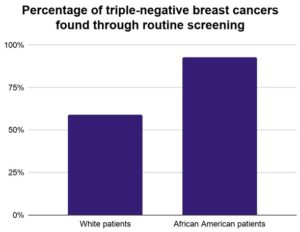
Breast screening reduces race-related cancer disparities
Article by AuntMinnie.com
February 20, 2020 — African American women have a 40% higher rate of breast cancer mortality than white women, partially because of increased incidence of triple-negative breast cancer. But screening mammography might improve that statistic, according to a research letter published online on February 19 in JAMA Surgery.
The new study found African American women with triple-negative breast cancers identified through routine screening had significantly improved survival rates. In fact, early detection through routine screening might entirely remove race as a disparity in triple-negative breast cancer survival rates.
“We report equal outcomes among equitably treated African American patients and white American patients with [triple-negative breast cancer],” wrote the authors, led by Yalei Chen, PhD, from the Henry Ford Cancer Institute in Detroit.
Mammography can help with early identification of breast cancer, but triple-negative breast cancer can still be hard to detect through imaging. The researchers wondered whether regular breast screening could help identify triple-negative breast cancers and ultimately reduce disparities in breast cancer results for African American women.
To find out, they used data from 106 African American and 87 white women who were diagnosed with nonmetastatic triple-negative breast cancer between January 2011 and December 2015.
Breast screening led to a slightly higher cancer detection rate for African American women than for white women. Women whose cancers were identified through screening had more cases of T1 tumors and node-negative cancers. They also were more likely to have a lumpectomy.

Triple-negative breast cancers identified through routine screening greatly improved the survival rate for African American patients. The same was not true for white patients, although white women were far more likely to undergo contralateral prophylactic mastectomy.
In the analysis, patients’ race, age, histology, body mass index, and insurance status were not associated with four-year survival rates. Rather, cancers detected through screening and cancers with high-grade pathology were the only factors significantly linked to survival.
“Screening mammography successfully detected early-stage [triple-negative breast cancer], improving outcomes for both African American and white American patients,” the authors concluded. “Screening mammography is therefore an important strategy for reducing race/ethnicity-associated breast cancer disparities by optimizing overall survival for both population subsets.”
